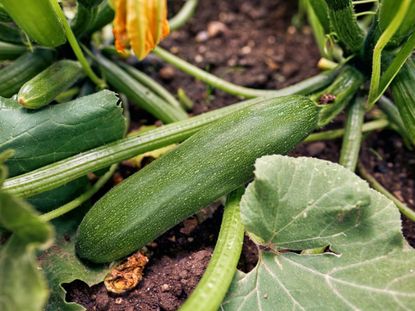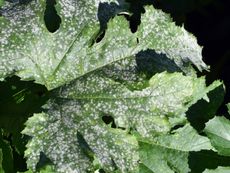Zucchini Problems: What Causes Bumps On Zucchini


Those big, beautiful leaves of zucchini plants protect their bounty of fruit from the elements, allowing for what seems like a never-ending supply of straight, smooth-skinned zucchinis. For most gardeners, the question of how to get rid of so many fruits is foremost in their minds, but when a gardener has bumpy zucchini fruit, disposing of excess fruit becomes a secondary issue to correcting the deformed zucchinis. Let's learn more about what to do for bumpy zucchini fruit.
Bumps on Zucchini
Although there may be an open-pollinated zucchini variety with bumpy skin, bumps on zucchini are not typical. Usually, bumps are considered a sign of one of the more serious zucchini problems, caused by one of many incurable plant viruses. Cucumber mosaic virus, watermelon mosaic virus, papaya ringspot virus, squash mosaic virus, and zucchini yellow mosaic virus can all cause these bumpy, deformed fruits. Symptoms of the many viruses in zucchini may bear close resemblance to one another, with common symptoms like scattered yellow patches on young or maturing leaves, leaf deformation, and irregular bumps or yellow spots on zucchini fruits. Stunting of plants often occurs, especially if the zucchini plant contracted the virus early in life or the seed itself was infected. A less common cause can be due to rapid growth or an excess of calcium in the soil.
Preventing Viral Related Zucchini Problems
There is no way to treat zucchinis once they're infected with viruses, but there are many preventative measures you can take at planting time, especially if you have lost crops to viruses before. Many viral pathogens are transmitted by sucking insects, like cucumber beetles or aphids, but they can also spread through infected seeds that mature into infected plants. Do not save zucchini seeds if there's any question as to the viral status of the mother plant. Instead, order certified virus-free seeds from a reputable supplier. If you direct seed your zucchinis, take some extra time to lay down reflective mulch and row covers to protect your zucchinis from virus-vectoring sucking pests. Transplants raised in a greenhouse need to be carefully monitored for insect pests. You can slow the spread of zucchini viruses in your garden by keeping the grass and weeds in your yard closely trimmed, since weedy and overgrown areas are very attractive to the bugs. When viral infections become obvious, remove the infected plants immediately to reduce the chance of spreading disease further. Always work with disease-free plants before moving to the diseased ones, as some plant viruses can be passed on dirty tools or clothing, especially when grafting or pruning zucchinis.
Gardening tips, videos, info and more delivered right to your inbox!
Sign up for the Gardening Know How newsletter today and receive a free download of our most popular eBook "How to Grow Delicious Tomatoes."

Kristi Waterworth was a regular contributor to Gardening Know How for many years, answering countless queries on plant pests and diseases.
-
 Clever Vertical Vegetable Garden Ideas For Small Spaces – 7 Ways To Save Space
Clever Vertical Vegetable Garden Ideas For Small Spaces – 7 Ways To Save SpaceShort on garden space? Learn some vegetable garden ideas for small spaces that are fun and easy.
By Mary Ellen Ellis
-
 26 Different Types Of Orchids – With Pictures & Information
26 Different Types Of Orchids – With Pictures & InformationDiscover stunning orchid types to grow in your home and garden – from easy beginner varieties to rare and exotic species that are the preserve of experts.
By Melanie Griffiths
-
 Learn What To Do With Too Much Zucchini
Learn What To Do With Too Much ZucchiniWhen you have a bumper crop of zucchini, remember there’s a special day that invites you to stealthily put the excess on your neighbor’s porch. Really. Read on.
By Bonnie L. Grant
-
 Golden Zucchini Plants: How To Grow Golden Zucchini In The Garden
Golden Zucchini Plants: How To Grow Golden Zucchini In The GardenZucchini has been a garden staple for centuries. If you're a bit tired of the typical green zucchini, try growing golden zucchini plants. A twist on an old favorite with brilliant yellow color, the following article contains golden zucchini information.
By Amy Grant
-
 Zucchini Plant Protection: Protecting Zucchini Plants From Frost And Pests
Zucchini Plant Protection: Protecting Zucchini Plants From Frost And PestsZucchini is a generally easy to grow, reliably prolific producer - as long as you can keep pests away. Early frosts can also dash your hopes for zucchini bread and other squash treats. In the following article, we'll discuss how to protect zucchini squash from both.
By Amy Grant
-
 Zucchini Leaves Turning Yellow: Reasons For Yellow Leaves On Zucchini
Zucchini Leaves Turning Yellow: Reasons For Yellow Leaves On ZucchiniIf you see the leaves on your zucchini plants turning yellow, don’t panic. Learn about the causes and ways to fix the problem.
By Amy Grant
-
 Zucchini Squash Harvesting: When Is Zucchini Ready To Pick
Zucchini Squash Harvesting: When Is Zucchini Ready To PickIt's not always easy to know when to pick fruits and vegetables, and zucchini is no exception. So when is zucchini ready to pick? Find out all the dirt on how and when to harvest zucchini in the article that follows.
By Amy Grant
-
 Zucchini Plant Fertilizer: Tips On Feeding Zucchini Plants
Zucchini Plant Fertilizer: Tips On Feeding Zucchini PlantsZucchini is one of the most popular summer squash varieties to grow in the vegetable garden. To get the highest yield of fruit, you may question "should I fertilize zucchini." The following article contains information on zucchini fertilizer requirements.
By Amy Grant
-
 Zucchini Squash Diseases: Common Diseases Of Zucchini Plants
Zucchini Squash Diseases: Common Diseases Of Zucchini PlantsSadly, there are a few zucchini plant diseases that you need to watch for in order to reap that bountiful harvest. Treating zucchini diseases often starts with soil preparation, crop rotation and a little pre-planning to minimize any potential issues. Learn more here.
By Bonnie L. Grant
-
 Zucchini Companion Plants: Best Plants To Grow With Zucchini
Zucchini Companion Plants: Best Plants To Grow With ZucchiniAre you wondering about companion planting or what grows well with zucchini? Gardeners can take advantage of several plants that are compatible with zucchini. This article will help get you started.
By Mary H. Dyer